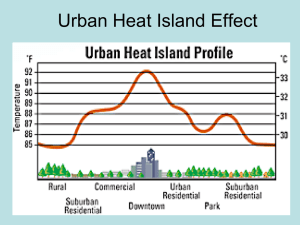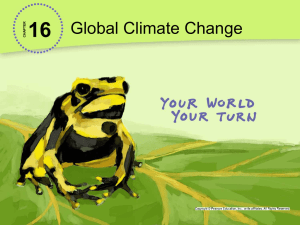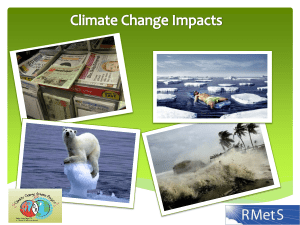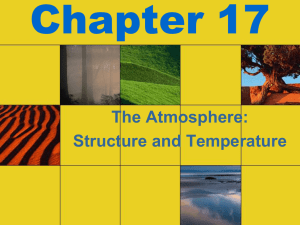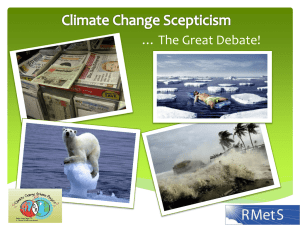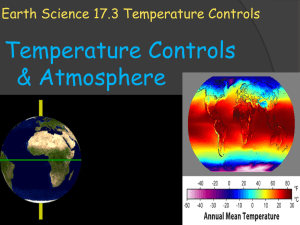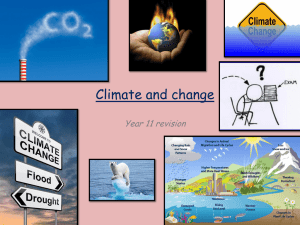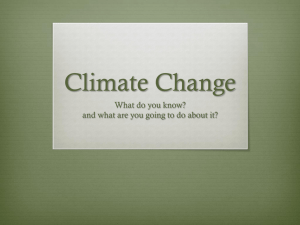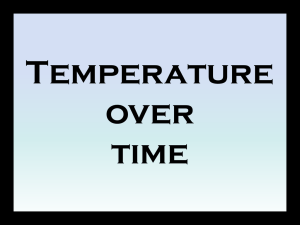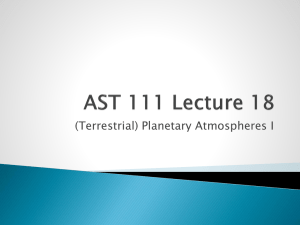climate change - St. Francis Xavier Church , Panvel
advertisement
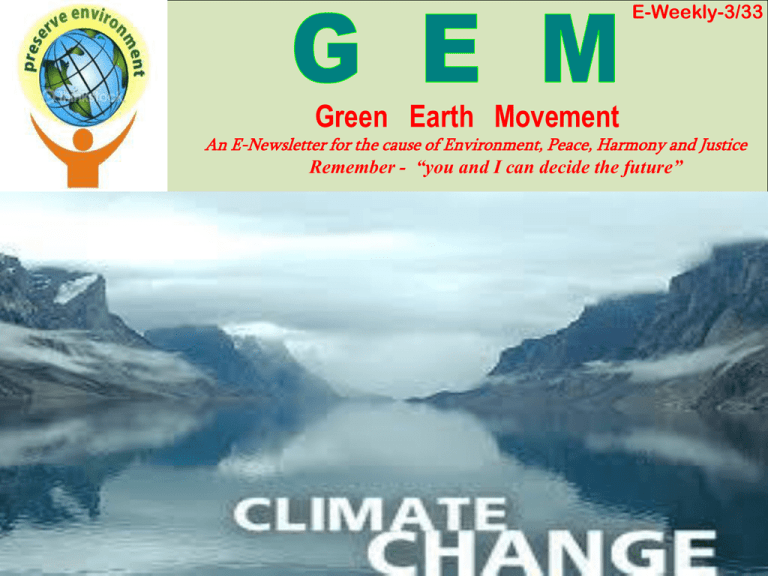
E-Weekly-3/33 Green Earth Movement An E-Newsletter for the cause of Environment, Peace, Harmony and Justice Remember - “you and I can decide the future” Our world is always changing. Look out your window long enough, and you might see the weather change. Look even longer, and you'll see the seasons change. The Earth's climate is changing, too, but in ways that you can't easily see. The Earth's climate is getting warmer, and the signs are everywhere. Rain patterns are changing, sea level is rising, and snow and ice are melting sooner in the spring. As global temperatures continue to rise, we'll see more changes in our climate and our environment. These changes will affect people, animals, and ecosystems in many ways. We shall try to learn the 3 aspects of climate change. That is: CAUSES, FFECTS & SOLUTIONS 1. Causes of climate change The earth's climate is dynamic and always changing through a natural cycle. What the world is more worried about is that the changes that are occurring today have been speeded up because of man's activities. These changes are being studied by scientists all over the world who are finding evidence from tree rings, pollen samples, ice cores, and sea sediments. The causes of climate change can be divided into two categories - those that are due to natural causes and those that are created by man. 1-A] Natural causes There are a number of natural factors responsible for climate change. Some of the more prominent ones are continental drift, volcanoes, the earth's tilt, ocean currents, and comets and meteorites. Let's look at them in a little detail. 1-a} Continental drift You may have noticed something peculiar about South America and Africa on a map of the world - don't they seem to fit into each other like pieces in a jigsaw puzzle? About 200 million years ago they were joined together! Scientists believe that back then, the earth was not as we see it today, but the continents were all part of one large landmass. The continents that we are familiar with today were formed when the landmass began gradually drifting apart, millions of years back. This drift also had an impact on the climate because it changed the physical features of the landmass, their position and the position of water bodies. The separation of the landmasses changed the flow of ocean currents and winds, which affected the climate. This drift of the continents continues even today; the Himalayan range is rising by about 1 mm (millimeter) every year because the Indian land mass is moving towards the Asian land mass, slowly but steadily. 1-b} Volcanoes When a volcano erupts it throws out large volumes of sulphur dioxide (SO2), water vapour, dust, and ash into the atmosphere. Although the volcanic activity may last only a few days, yet the large volumes of gases and ash can influence climatic patterns for years. Millions of tonnes of sulphur dioxide gas can reach the upper levels of the atmosphere (called the stratosphere) from a major eruption. The gases and dust particles partially block the incoming rays of the sun, leading to cooling. Sulphur dioxide combines with water to form tiny droplets of sulphuric acid. These droplets are so small that many of them can stay aloft for several years affecting the temperature. The extent to which this occurs is an ongoing debate. 1-c} The earth's tilt The earth makes one full orbit around the sun each year. It is tilted at an angle of 23.5° to the perpendicular plane of its orbital path. For one half of the year when it is summer, the northern hemisphere tilts towards the sun. In the other half when it is winter, the earth is tilted away from the sun. If there was no tilt we would not have experienced seasons. Changes in the tilt of the earth can affect the severity of the seasons - more tilt means warmer summers and colder winters; less tilt means cooler summers and milder winters. 1-d} Ocean currents The oceans are a major component of the climate system. They cover about 71% of the Earth and absorb about twice as much of the sun's radiation as the atmosphere or the land surface. Ocean currents move vast amounts of heat across the planet - roughly the same amount as the atmosphere does. But the oceans are surrounded by land masses, so heat transport through the water is through channels. Winds push horizontally against the sea surface and drive ocean current patterns. Certain parts of the world are influenced by ocean currents more than others. 1-B] Human causes The Industrial Revolution in the 19th century saw the large-scale use of fossil fuels for industrial activities. These industries created jobs and over the years, people moved from rural areas to the cities. This trend is continuing even today. More and more land that was covered with vegetation has been cleared to make way for houses. Natural resources are being used extensively for construction, industries, transport, and consumption. Consumerism (our increasing want for material things) has increased by leaps and bounds, creating mountains of waste. Also, our population has increased to an incredible extent. All this has contributed to a rise in greenhouse gases like Carbon dioxide and Mathene in the atmosphere affecting the climate of the earth. 2. EFFECTS OF CLIMATE CHANGE What's happening now? Temperatures have risen during the last 30 years, and 2000 to 2009 was the warmest decade ever recorded. As the Earth warms up, heat waves are becoming more common in some places, including the United States. Heat waves happen when a region experiences very high temperatures for several days and nights. What will happen in the future? The choices we make now and in the next few decades will determine how much the planet's temperature will rise. While we are not exactly sure how fast or how much the Earth's average temperature will rise, we know that: If people keep adding greenhouse gases into the atmosphere at the current rate, the average temperature around the world could increase by about 4 to 12°F by the year 2100. If we make big changes, like using more renewable resources instead of fossil fuels, the increase will be less—about 2 to 5°F. Why does it matter? Higher temperatures mean that Heat waves are likely to happen more often and last longer, too. Heat waves can be dangerous, causing illnesses such as heat cramps and heat stroke, or even death. Warmer temperatures can also lead to a chain reaction of other changes around the world. That's because increasing air temperature also affects the oceans, weather patterns, snow and ice, and plants and animals. The warmer it gets, the more severe the impacts on people and the environment will be. SEE NEXT-impact of climate change on various human activities: 2-a} AGRICULTURE The crops that we grow for food need specific conditions to thrive, including the right temperature and enough water. A changing climate could have both positive and negative effects on crops. For example, the northern parts of the United States have generally cool temperatures, so warmer weather could help certain crops grow. In southern areas where temperatures are already hot, even more heat could hurt crop growth. Global climate change will also affect agriculture and food supply in many other ways. 2-b} CROP LOSSES Climate change could make it too hot to grow certain crops, and droughts caused by climate change could reduce the amount of water available for irrigation. Climate change is also likely to cause stronger storms and more floods, which can damage crops. Higher temperatures and changing rainfall patterns could help some kinds of weeds and pests to spread to new areas. If the global temperature rises an additional 3.6°F, U.S. corn production is expected to decrease by 10 to 30 percent. 2-c} ENERGY Global climate change will affect how much energy we need and when we need it. As temperatures rise, more people will need to keep cool by using air conditioning, which uses a lot of electricity. However, some people might need less energy to heat buildings in the winter because it may not get as cold as it used to be. Climate change could also make it harder to produce certain types of electricity, such as hydropower. 2-d} WATER SUPPLIES Climate change is affecting where, when, and how much water is available for people to use. Many parts of the world already have very little water, and climate change could make this problem worse. Rising temperatures, changing precipitation patterns, and increasing droughts will affect the amount of water in lakes, rivers, and streams, as well as the amount of water that seeps into the ground to replenish ground water. 2-e} LAKES, RIVERS, AIRSTREAMS Many places rely on snowmelt to fill the lakes, rivers, and streams that help keep drinking water reservoirs full and provide water to irrigate crops. For example, many parts of the western United States depend on water from the Colorado River, which is fed by melting snowpack in the Rocky Mountains. Less snowpack and earlier snowmelt will reduce the amount of water flowing into The Colorado and other rivers. 2-f} TEMPERATURE RELATED ILLNESS Heat waves are uncomfortable for everyone, but for infants and young children, the elderly, and people who are already sick, they can be especially dangerous. Extreme heat can cause Illnesses such as heat cramps, heat stroke, and even death. A 2003 heat wave in Europe caused about 50,000 deaths, and a 1995 heat wave in Chicago caused more than 600 deaths. In fact, heat waves cause more deaths in the United States every year than hurricanes, tornadoes, floods, and earthquakes combined. On the flip side, as the world gets warmer, the number of illnesses and deaths related to extreme cold (like hypothermia and frostbite) may decrease. 2-g} DISAPPEARING HABITATS As the Earth gets warmer, plants and animals that need to live in cold places, like on mountaintops or in the Arctic, might not have a suitable place to live. If the Earth keeps getting warmer, up to one–fourth of all the plants and animals on Earth could become extinct within 100 years. Every plant and animal plays a role in the ecosystem (for example, as a source of food, a predator, a pollinator, a source of shelter), so losing one species can affect many others. 2-h} LOSS OF CORAL REEFS Coral reefs are created in shallow tropical waters by millions of tiny animals called corals. Each coral makes a skeleton for itself, and over time, these skeletons build up to create coral reefs, which provide habitat for lots of fish and other ocean creatures. Warmer water has already caused coral bleaching (a type of damage to corals) in many parts of the world. By 2050, live corals could become rare in tropical and sub-tropical reefs due to the combined effects of warmer water and increased ocean acidity caused by more carbon dioxide in the atmosphere. The loss of coral reefs will reduce habitats for many other sea creatures, and it will disrupt the food web that connects all the living things in the ocean. 2-i} VANISHING FORESTS Forests provide homes for many kinds of plants and animals. They also protect water quality, offer opportunities for recreation, and provide people with wood. Forests are sensitive to many effects of climate change, including shifting weather patterns, drought, wildfires, and the spread of pests like the mountain pine beetle. Unlike some animals, trees can't just get up and move when the temperature gets too hot or other conditions change! 2-j} RECREATION In addition to causing all sorts of problems, such as heat waves, droughts, and coastline damage, warmer temperatures could also affect people's jobs, recreational activities, and hobbies. For example, in areas that usually experience cold winters, warmer temperatures could reduce opportunities for skiing, ice fishing, and other winter sports. Also, rising sea level could wash away beaches. 2-k} DISAPPEARING BEACHES Higher sea level will mean less space at the beach. A combination of stronger storms and sea level rise could increase the rate of erosion along the coast, and some beaches could disappear altogether. 3-SOLUTIONS TO CLIMATE CHANGE 3-a} Forego Fossil Fuels The first challenge is eliminating the Burning of coal, oil and, eventually, Natural gas. This is perhaps the most daunting challenge as denizens of richer nations literally eat, wear, work, play and even sleep on the products made from such fossilized sunshine. And citizens of developing nations want and arguably deserve the same comforts, which are largely thanks to the energy stored in such fuels. So try to employ alternatives when possible—plant-derived plastics, biodiesel, wind/solar power—and to invest in the change, be it by divesting from oil stocks or investing in companies practicing carbon capture and storage. 3- b} Infrastructure Upgrade: Buildings worldwide contribute around one third of all greenhouse gas emissions (43 percent in the U.S. alone), even though investing in thicker insulation and other costeffective, temperature-regulating steps can save money in the long run. Of course, it takes a lot of cement, a major source of greenhouse gas emissions, to construct new buildings and roads. But energy-efficient buildings and improved cement-making processes (such as using alternative fuels to fire up the kiln) could reduce greenhouse gas emissions in the developed world and prevent them in the developing world. 3- c} Move Closer to Work Transportation is the second leading source of greenhouse gas emissions in the U.S. One way to dramatically curtail transportation fuel needs is to move closer to work, use mass transit, or switch to walking, cycling or some other mode of transport that does not require anything other than human energy. There is also the option of working from home and telecommuting several days a week. Cutting down on long-distance travel would also help, most notably airplane flights, which are one of the fastest growing sources of greenhouse gas emissions and a source that arguably releases such emissions in the worst possible spot (higher in the atmosphere). 3-d} Consume Less The easiest way to cut back on greenhouse gas emissions is simply to buy less stuff. Whether by forgoing an automobile or employing a reusable grocery sack, cutting back on consumption results in fewer fossil fuels being burned to extract, produce and Ship products around the globe. Think green when making purchases. For instance, if you are in the market for a new car, buy one that will last the longest and have the least impact on the environment. Thus, a used vehicle with a hybrid engine offers superior fuel efficiency over the long haul while saving the environmental impact of new car manufacture. Paradoxically, when purchasing essentials, such as groceries, buying in bulk can reduce the amount of packaging—plastic wrapping, cardboard boxes and other unnecessary materials. Sometimes buying more means consuming less. 3-e} Be Efficient A potentially simpler and even bigger impact can be made by doing more with less. Citizens of many developed countries are profligate wasters of energy, whether by speeding in a gas-guzzling sport-utility vehicle or leaving the lights on when not in a room. Good driving—and good car maintenance, such as making sure tires are properly inflated —can limit the amount of greenhouse gas emissions from a vehicle and, perhaps more importantly, lower the frequency of payment at the pump. Similarly, using more efficient refrigerators, air conditioners and other appliances can cut electric bills, while something as simple as weatherproofing the windows of a home can reduce heating and cooling bills. Such efforts can also be usefully employed at work, whether that means installing more efficient turbines at the power plant or turning the lights off when you leave the office. 3-f} Eat Smart, Go Vegetarian? A surprisingly high percentage of our daily impact on the environment comes from our food choices, and one obvious benefit of vegetarianism is its relatively low impact. Just think about it: Eating grain instead of feeding that grain to a cow for months or years is a more efficient, less wasteful way of getting the nutrition and energy needed to live happily. Simply, it just takes less grain, which takes less land, which requires less fertilization and water, and which reduces erosion of top soil. 3-g} Stop Cutting Down Trees Every year, 33 million acres of forests are cut down. Timber harvesting in the tropics alone contributes 1.5 billion metric tons of carbon to the atmosphere. That represents 20 percent of human-made greenhouse gas emissions and a source that could be avoided relatively easily. Improved agricultural practices along with paper recycling and forest management—balancing the amount of wood taken out with the amount of new trees growing—could quickly eliminate this significant chunk of emissions. And when purchasing wood products, such as furniture or flooring, buy used goods or, failing that, wood certified to have been sustainably harvested. The Amazon and other forests are not just the lungs of the earth, they may also be humanity's best short-term hope for limiting climate change. 3-h} Unplug Believe it or not, U.S. citizens spend more money on electricity to power devices when off than when on. Televisions, stereo equipment, computers, battery chargers and a host of other gadgets and appliances consume more energy when seemingly switched off, so unplug them instead. Purchasing energy-efficient gadgets can also save both energy and money—and thus prevent more greenhouse gas emissions. To take but one example, efficient battery chargers could save more than one billion kilowatt-hours of electricity—$100 million at today's electricity prices—and thus prevent the release of more than one million metric tons of greenhouse gases. Swapping old incandescent light bulbs for more efficient replacements, such as compact fluorescents (warning: these light bulbs contain mercury and must be properly disposed of at the end of their long life), would save billions of kilowatt-hours. In fact, according to the EPA, replacing just one incandescent light bulb in every American home would save enough energy to provide electricity to three million American homes. To conclude with a quote of Archbishop Desmond Tutu……….. Do your little bit of good where you are; it's those little bits of good put together that overwhelm the world” Archbishop Desmond Tutu This PowerPoint Presentation is prepared by GEM Team (courtesy: internet). Other GEM PowerPoint Presentations are: Zero Garbage – Nobel for India! Solar Energy Junk Food – A slow poison Twenty Tips To Save Nature Plastic – a boon or bane? Green Passion. Soft drink – A Health Hazard Waste to energy Rain Water Harvesting Eco-friendly Religions Happy Green Diwali These PPTs may be downloaded from our website: www.stfrancisxavierpanvel.in – GEM section
